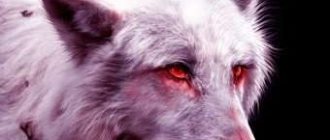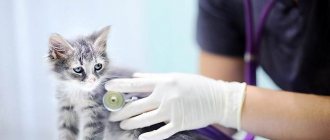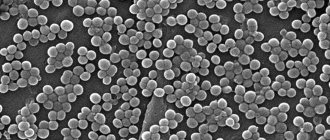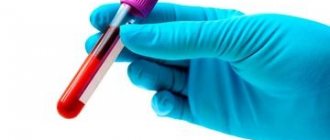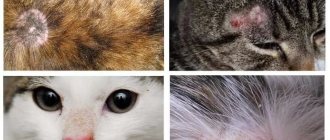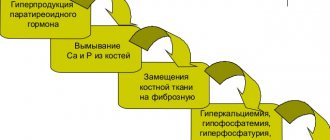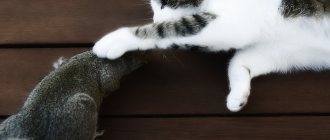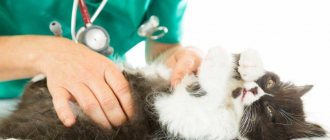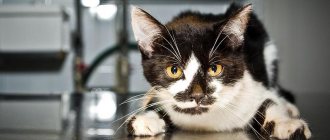What is distemper in cats
This is a highly contagious viral disease, which is also known as infectious parvovirus enteritis or panleukopenia. When infected, the number of all types of leukocytes in the bloodstream sharply decreases, the intestinal epithelium is affected, and a generalized infection affects the lymphatic system. Panleukopenia occurs more often in kittens - the still fragile body is more susceptible to the virus. The most dangerous time is spring and summer, when animals breed. Distemper in cats shows a high mortality rate, so it is important to start treatment in a timely manner - when the first signs appear.
Panleukopenia virus in animals
Feline distemper occurs as a result of damage to the animal's body by parvovirus, the name of which in Latin is Virus panleukopenia feline (FPV). The virus retains its virulence in the external environment for up to one year, while it does not decompose when heated for an hour to 60°C, does not respond to changes in acidity ranging from pH 3.0 to 9.0, is not afraid of frost, and can withstand the effects of pepsin and trypsin , diethyl ether and chloroform - thanks to such amazing resistance, the pathogen can easily infect more and more victims.
How is it transmitted?
The sources of this deadly disease are sick cats and virus carriers. Parvovirus is shed in stool (feces, urine) or saliva. There are several ways of contracting panleukopenia:
- During oral contact. The virus can enter the oral cavity along with saliva. More often this happens when drinking water or eating food infected with viral particles from a virus carrier or a sick animal.
- By airborne droplets. A healthy individual becomes ill with panleukopenia while in close proximity to a patient.
- By contact method. Infection occurs through personal belongings, clothing or shoes of the owner of a furry animal who has been in contact with a virus-carrying cat. In addition, parvovirus survives on litter trays, harnesses, bowls and toys for up to a year.
- In utero. The virus easily passes through the placental barrier and penetrates the fetus. Kittens infected at an early stage of pregnancy die (decompose inside, mummify) before birth or die 1-2 days after birth. Babies infected at a late stage often have congenital underdevelopment of the cerebellum.
- Transmissible method - when the causative agent of panleukopenia is carried by blood-sucking parasites - ticks, fleas, bedbugs.
Almost all representatives of the cat family can become infected with parvovirus: tigers, leopards, cheetahs. Among domestic animals, distemper is a widespread disease, to which unvaccinated kittens under one year of age and cats older than 6-8 years are more susceptible: young animals are predisposed to the disease due to undeveloped immunity, and older pets with age lose the ability to resist various viruses, because the immune properties of the body become weaker.
Pregnant cats and small kittens are also at risk of contracting panleukopenia. The chances of contracting plague increase in babies over two weeks of age. This is explained by the fact that the mother’s immunity weakens, and the baby’s own immune system is not enough to resist such a dangerous virus. If we consider breed predisposition, parvovirus is most dangerous for British representatives, Maine Coons, Siamese and Persian cats.
Is it dangerous for humans?
Panleukopenia is not dangerous to humans. They can only act as carriers of parvovirus on their outerwear, shoes and other things. Owners of several pets should be careful: if one cat has become infected with infectious enteritis, it must be isolated from a healthy cat and strictly quarantined. It is noteworthy that dogs are not afraid of the virus. Although they can get distemper, it can be caused by a completely different type of parvovirus.
Causes of occurrence (paths of infection)
The causative agent of plague is parvovirus , resistant to physical and chemical influences. Being in the environment, it poses a danger throughout the year. Infection occurs in the following ways:
- Living together or communicating while walking with an infected cat. Please note that a recovered animal becomes a carrier of the virus for a year after recovery. The room in which such a pet was located is also dangerous.
- Contact with body fluids of the sick person, including saliva, nasal secretions, vomit and feces. The pet can sniff them, and the owner can bring them on shoes or clothes.
- Insect bite. When a blood-sucking insect comes into contact with an infected cat, the virus is transmitted to the next bitten person.
- Intrauterine transmission. When the disease occurs during pregnancy, the offspring usually does not survive. Distemper in cats provokes: resorption of fruits;
- the appearance of stillborn kittens;
- miscarriages;
- mummification of embryos.
Parvovirus
The risk of infection depends on a number of factors:
- Age . Kittens under one year old and cats over 6 years old have weak immunity and are more susceptible to diseases.
- Immunity . An animal that has undergone surgery or is weakened by a chronic disease does not have the internal resources to fight the virus.
Despite the survivability of the virus, you should not be afraid of a sick pet. The disease does not pose a threat to humans.
Forms of the disease
Distemper in cats develops subacutely, acutely or superacutely (with lightning speed). Find out more about these forms of the disease:
- Subacute form – typical for cats with strong immunity. The incubation period can last up to several weeks. Clinical signs of plague in the subacute form are not clearly expressed. Full recovery is possible provided that the animal's immune system is at a high level.
- Acute - in this case the incubation period is 1–2 days. Panleukopenia in this form mainly affects adult animals.
- The fulminant form of the disease is typical for young furry pets. Distemper in a kitten develops rapidly - literally within a few hours after the pathogen enters the body. The hyperacute form of the disease is clinically similar to the symptoms of rabies, while the signs often do not even have time to develop, and the animal dies in a very short time.
First signs
The virus manifests itself within 2–8 days from the onset of the disease. If the course of the disease is acute, the symptoms are:
- sudden refusal of food;
- oppression;
- increased body temperature, which rises to 40°C and above in 1-2 days;
- the cat behaves as if it is constantly thirsty, but at the same time drinks little;
- vomiting with dark yellow-green mucus appears;
- urine turns from dark yellow to light orange;
- the oral mucosa dries out;
- the blood vessels of the soft palate turn blue;
- During the examination, rhinitis, conjunctivitis, and swelling of the lining of the larynx are noted.
Symptoms of plague (panleukopenia)
A sick animal tries to hide in a secluded place and loses interest in everything. During illness, sits hunched over or lies on his stomach with outstretched limbs, head thrown back.
Painful spasms prevent the cat from drinking even when very thirsty. Breathing is carried out through the mouth, the mucous membranes acquire a blue tint. Due to cardiac disorders, a dry cough appears. Traces of blood are found in vomit and feces.
The main symptoms of feline distemper:
- rise in body temperature to 41º C;
- lack of appetite, refusal to drink;
- sunken eyes;
- dry skin;
- dullness and unkempt appearance of the coat;
- weakness;
- loose stools;
- vomit.
Sometimes a mild course of the disease is possible. The cat has mild discomfort. The disease is diagnosed in this case using a blood test.
In acute cases, the pet’s condition rapidly deteriorates. Fever and prolonged vomiting begins with the release of a greenish-yellow mass. Urine becomes dark or light orange. The stool becomes liquid. Discharge appears from the eyes and nose. Due to dehydration, the animal loses a lot of weight. The appearance of moist rales indicates the onset of pulmonary edema. The animal may fall into a coma and convulsions may begin.
In some cases, a hyperacute course of the disease is observed, followed by sudden death.
You should take your pet to a veterinarian as soon as possible to confirm the diagnosis. It is necessary to begin treatment at home in the first hours after the onset of symptoms. This will increase your chances of recovery.
Symptoms
Parvovirus first affects the small intestine, then the bone marrow, the lymphatic system, and then occupies almost the entire body. Each form of the disease is characterized by certain symptoms. Fulminant is a course of panleukopenia that can infect kittens up to 2 weeks of age. This form of distemper leads to a sharp deterioration in health, manifested in refusal to suck milk, plaintive squeaking, and apathy.
Even if timely treatment is started, the baby will most likely die within 2 days. There are other symptoms of feline distemper, which occurs in a hyperacute form:
- lethargy;
- lack of response to his mother;
- matted, disheveled, unkempt, dull fur;
- reluctance to move, paralysis;
- trembling of limbs, convulsions;
- lack of appetite, thirst;
- vomiting blood or yellow or green foam.
In kittens aged 3 to 7 months, the nervous system suffers during the fulminant course of the disease. At the same time, to the above signs are added symptoms very similar to those that occur with rabies: the cat is frightened by any extraneous sounds, hides in distant secret corners, he begins to fear light, sunlight, he squeaks heart-rendingly when frightened, and nervous overexcitation is observed. After some time, loose stools, which have a specific foul odor, are added to the symptoms. In some cases, blood appears in the excrement.
The acute form of the disease occurs in adults. The symptoms differ from those characteristic of the fulminant form of plague and are as follows:
- interest in everything that is happening disappears, the cat constantly lies, does not react to the actions and voice of the owner;
- the temperature rises sharply to 41°C;
- heavy breathing appears;
- the animal refuses any food, even the most beloved;
- vomiting begins with yellow or green foam, in which after 36–48 hours particles of blood and mucus appear;
- rumbling in the stomach, watery diarrhea appears;
- red spots appear on the skin, which first fester and then disappear.
The high temperature does not last long, then drops to 37°C. Lower rates are harbingers of imminent death of the animal. A sick cat is very thirsty, but due to spasms of the larynx and pain in the abdominal cavity, she cannot. When the parvovirus reaches the cat's heart, it begins to breathe with its mouth open, and heart failure and tachycardia develop. When plague affects the respiratory organs (lungs, bronchi), the following symptoms are added:
- copious nasal discharge;
- redness of the eyes, watery eyes;
- hot, dry nose;
- wheezing in the chest when breathing, cough;
- frequent coughing;
- foci of inflammation on the epidermis filled with pus.
The subacute form is the most favorable form of the disease, in which almost all the main markers of plague can be traced, but their manifestations are insignificant. In this form, the disease occurs mainly in animals with stable immunity, in vaccinated animals and in individuals who are naturally in good health.
- How to treat cervical osteochondrosis
- How to lose weight during menopause
- Pomegranate juice: benefits and properties
Symptoms of panleukopenia
The first signs of distemper in cats do not appear immediately after infection, but after a certain time, the so-called incubation period. Of course, there are no exact numbers. Much depends on the age of the pet, its immunity, as well as the course of the disease, but in most cases the incubation period lasts 9-12 days.
If panleukopenia in a cat is hyperacute, then the animal can die very quickly, and the owner will not even have time to start therapy. More often than not, feline distemper is an acute disease. There are nervous, intestinal and pulmonary forms of the disease.
Hyperacute course
It is rarely registered, but this does not mean that it is not worth talking about. Most often, very young kittens up to one year old suffer from it. And they develop a disease that damages the nervous system, so they experience nervous agitation (the animal begins to move a lot and quickly), appetite and desire to drink water disappear, and excessive timidity (kids try to hide).
Even at night, sick kittens do not sleep, and whitish (or yellowish) vomiting with foam, diarrhea, and tousled fur appear. Convulsions are noted, then paralysis and paresis of both limbs and sphincters of internal organs. Since the course is hyperacute, the kitten’s death occurs within the first two days.
Acute course
The most common forms are intestinal and pulmonary. And the form determines what symptoms of feline distemper will develop and how long the incubation period will last.
Pulmonary form
As the name implies, feline distemper, or panleukopenia, is characterized by damage to the respiratory system (bronchi, lungs, and upper respiratory tract). Cloudy-white deposits (in the form of films) appear on the mucous membranes of the eyes and nose, and hemorrhages and ulcers often appear in their place. And also the mucous membranes of the respiratory tract become very swollen and inflamed (visibly reddened).
As the plague progresses, pus accumulates in the corners of the eyes and nasal passages, which dries out. The resulting crusts clog the lacrimal glands and nose. Breathing becomes noticeably more difficult, so it becomes more frequent and shallow. Very quickly the tissues begin to starve due to the lack of oxygen they need.
INTERESTING TO KNOW: Symptoms and treatment of calcevirus infection in cats and kittens
In more severe forms of distemper, sick cats develop heart failure, which leads to cyanosis (cyanosis) of the mucous membranes. Dehydration and intoxication are noted. Fabrics lose their elasticity, and the coat becomes dull and disheveled. The nose is very hot, rough and dry.
Intestinal form
- With this form, the first signs of distemper in infected cats will appear 2-8 days after infection. Body temperature rises to 41 degrees, the animal loses appetite and desire to drink. The purr becomes very lethargic. There is severe vomiting with bile.
- Feline panleukopenia has symptoms unique to this disease. A distinctive feature is that no matter how bad the pet is, no matter how close to the bowl he bends, he will not drink! But even if by some miracle the cat manages to drink, he will immediately start vomiting.
- The animal takes such poses that even an inexperienced owner understands that the pet has a tummy ache. If you listen closely, you can hear the sound of splashing in the intestines. All digestive organs are severely inflamed and extremely painful. Having touched the stomach, a sick cat will immediately begin to meow loudly, bite, and scratch due to pain.
- Diarrhea gradually appears. The feces are very liquid and terribly smelly, colorless, and may contain blood or fibrin strands (white). However, vomiting and diarrhea are irregular and are more often recorded when there is a secondary infection (as complications, calcivirus and bacterial diseases can also develop).
The death of animals with this form of the disease can occur at absolutely any stage, but often a sick cat dies 2-5 days after the appearance of clinical signs.
Diagnostics
Only a veterinarian can determine whether an animal has distemper. To do this, at the slightest suspicion of infection, the cat must be taken to the clinic, taking with you a passport containing vaccination information. The doctor makes the diagnosis based on medical history, examination, laboratory and clinical tests. First of all, the veterinarian checks the stool for the presence of parvovirus particles - this test is performed using the polymerase chain reaction (PCR method). It should be noted that the PRC method will show a positive result only if the cat was vaccinated shortly before infection.
A characteristic sign of infection with panleukopenia is a sharp decrease in white blood cells. For this reason, a blood test is prescribed for a sick pet. The veterinarian carries out a differential diagnosis, because the signs of distemper in a cat are similar to the symptoms of pathologies such as poisoning, feline immunodeficiency, leukemia, pancreatitis or intestinal perforation.
??
Treatment of distemper in cats
This disease is treated comprehensively, and this should only be done by a veterinarian. Therapy is of two types - etiotropic and symptomatic. Etiotropic – aimed at destroying the virus. The treatment uses the drug Vitafel, an immunoglobulin that fights the viruses of rhinotracheitis, panleukopenia and calicivirosis. Enterostat also helps to overcome the disease: the dose is 20 mg/kg 1 time/day for 7 days.
Excellent results can be seen after using the antiviral drug Fosprenil: the medicine is administered intramuscularly in doses of 0.5 ml for cats weighing 1–5 kg and 0.2 ml for cats less than 1 kg. The number of injections is affected by the duration of treatment:
- on days 1–2 – 4 injections/day.
- on days 3–10 – 3 injections/day;
- on days 11-13 – 2 injections/day;
- on days 14-15 – 1 injection/day.
Symptomatic therapy is aimed at minimizing the symptoms of distemper in cats. With this treatment, you need to take into account the following recommendations:
- First, correct the acid-base and water-electrolyte balance of the body, i.e. reduce dehydration and neutralize intoxication. To do this, you need to inject a solution of sodium chloride intravenously or subcutaneously.
- In the absence of vomiting, you can use Ringer's solution or Regidron orally. Each of these medications must be mixed with 5% glucose and a quarter teaspoon of soda. The daily volume of such a drink for a cat is calculated using the formula: 50 ml per 1 kg.
- Increase urine output in order to rid the body of toxic products. In this case, it is advisable to use herbal preparations: lingonberry, horsetail, bearberry, etc.
- It is mandatory to carry out antibiotic therapy to destroy the secondary bacterial microflora - the use of broad-spectrum drugs is indicated.
- Use vitamin supplements in combination with iron-containing supplements. Such medications must contain folic, ascorbic acid, vitamins A, B, C. Iron-containing ones are, for example, Ferrodextran (1–2 ml for an adult animal) and Ursoferran (0.3 ml/animal).
- It is necessary to stimulate the body as a whole and improve metabolism. Catozal is perfect for these purposes - the drug is administered daily for a week in the dosage specified in the instructions.
- Use antispasmodic medications to relieve spasms and reduce intestinal pain. Dibazol, No-shpa, etc. are suitable.
Treatment
Knowing what symptoms panleukopenia has in cats and treatment can be selected. After all, based on the signs, you can understand exactly what form of the disease the cat has, and, therefore, it is easier to prescribe symptomatic therapy. First of all, they improve the living conditions: warm, dry and no drafts.
- Specific therapy exists. Hyperimmune serum (for example, Vitafen) helps to quickly overcome the virus. The serum contains ready-made antibodies that will prevent the pathogen from causing harm. However, it is better to use immunoglobulin against panleukopenia and immunostimulants, which will “stir up” the immune system.
- To prevent secondary bacterial infection from developing, the attending veterinarian will prescribe antibiotics, nitrofurans, and sulfonamides. Due to frequent vomiting, it is better to administer the drugs intramuscularly 1-2 times a day in a course (at least 5 days).
- In the intestinal form, toxins accumulate in the gastrointestinal tract and must be removed from the body. To do this, cleansing siphon enemas are given (it is better to use a cool solution to provoke contraction of the intestinal muscles and narrow the blood vessels). If the animal does not eat, then nutritional enemas are allowed up to 3-4 times a day (volume 20-200 ml).
- An antispasmodic will help reduce vomiting and pain.
- You should also not forget about vitamins, they will help you recover faster. If heart failure is registered, then it is necessary to use drugs that support the “motor” of the body.
- In case of severe dehydration and symptoms of intoxication, IV drips with physiological solutions (glucose, Ringer-Lock) are required.
- Do not forget that antibiotics kill all intestinal microflora, so bifidobacteria and drugs that restore the enzymatic function of the digestive tract are prescribed.
Drugs
When treating distemper, veterinarians may prescribe:
- saline solutions, calcium chloride - to restore cellular balance in case of dehydration;
- vitamins, iron supplements - to restore immunity;
- antiemetics - Regidron, Rieger (diluted with glucose with a small addition of soda);
- katazol - to normalize metabolic processes;
- no-spa, Dibazol - to relieve pain and spasms;
- diuretics to remove toxins and relieve intoxication, decoctions of bearberry, horsetail, and lingonberry leaves are indicated;
- gastroprotectors - to protect the gastric mucosa;
- non-steroidal anti-inflammatory drugs (NSAIDs) - to lower temperature, reduce inflammation, relieve pain.
INTERESTING TO KNOW: How pulmonary edema is treated in cats
Home care during illness
A sick animal requires special care. The cat should be kept in a warm, dry and darkened room, which should be regularly ventilated, taking it to another room during this time.
If the cat does not want to eat, there is no need to force-feed it.
Compliance with hygiene procedures is the key to quality treatment. You should clean the eyes, nose and muzzle from dirt and accumulations of pus using a cotton swab moistened with a medicinal solution. It is advisable to treat the room where the cat lies with a UV lamp or hypochlorite solution for disinfection, carry out wet cleaning twice a day, and remove feces as quickly as possible.
Remember that treatment with folk remedies for feline distemper is dangerous and can cause irreparable harm to the animal. Follow your veterinarian's instructions exactly!
Many owners believe that treating distemper in cats at home is possible with the help of vodka. Reviews from owners of sick animals indicate that this method does indeed take place, but only when it is not possible to take the animal to a specialist. In addition, this type of treatment is effective only in the first two days.
The recipe is very simple: one tablespoon of vodka is mixed with chicken yolk. The mixture is given to the patient three times a day, one tablespoon at a time. Treatment with vodka should take effect within a day.
But it is better, of course, not to risk the life and health of your pet and find an opportunity to show it to a specialist than to carry out treatment at home.
Treatment of distemper in kittens
While the symptoms of distemper appear, the owners need to take good care of the kitten, providing it with maximum comfort and care. Recovery largely depends on how strong the baby’s body is; it will take time, but the love and care of the owners can create a real miracle.
For each animal, treatment methods are different and selected individually, but there are general rules:
- the kitten is placed in a shaded and warm place;
- regularly ventilate the room;
- the animal must be kept clean, remembering that the secretions contain a huge number of viruses;
- the premises are subjected to regular disinfection;
- Do not force feed a sick kitten! After recovery, his appetite is restored, but he needs to be fed light, high-calorie foods: cottage cheese, lean meat broth. Then they give boiled sea fish, ground or chopped meat without fat, but cereals, herbs and any vegetables are prohibited. Portions should be small, and meals should be split, five times a day;
- food should be pleasantly warm, neither hot nor cold;
- The animal will follow the diet for at least 2 months.
Diet therapy
Now you know what feline distemper is, what symptoms and treatment exist. However, you should not forget about the nutrition of your recovering pet to make recovery easier.
- On the first day, only drink should be given: pure boiled water (can be with ascorbic acid, or with the addition of decoctions of medicinal herbs).
- To satiate your beloved pet, you can give broths (chicken, fish, beef), but do not cook for a second time, because... When you first cook it, the broth turns out too fatty. And fatty foods are too difficult for an inflamed digestive tract. Just remember that you cannot force water or feed the animal.
- Gradually offer the sick cat oatmeal or rice porridge (cook in water or broth) and monitor the behavior. If there was no vomiting or diarrhea, then the portion can be increased slightly. It is better to feed often, but little by little.
- On the 4-5th day, you can carefully add a raw or boiled egg - this is protein, but still be sure to see how the cat feels.
- By the end of the first week of treatment, provided that the purr tolerated the introduction of foods into the diet well, it can be transferred to its usual diet.
Diet
Distemper in cats is a serious disease, so after the animal is cured, it is important for the owner to take care of the appropriate nutrition for his pet. To do this you need to follow some recommendations:
- After the cat's appetite returns, the cat's menu should consist exclusively of light, slightly warm, pureed food.
- It is not recommended to feed your pet against his will - when he gets better, he will start eating on his own.
- Portions should be small, food should be given 5-6 times a day.
- It is allowed to feed low-fat broth, cottage cheese, kefir, and yogurt. After 3 days, you can gradually introduce a little boiled lean beef and fish fillet into the diet.
- Vegetables, fruits, grains, and any raw food are prohibited foods for cats that have just suffered from distemper - such foods can be given no earlier than after 2 months.
Disinfection
As already mentioned, plague is a very dangerous disease that is resistant to many external influences. To keep your recovering pet and other cats as safe as possible, you must follow the recommendations for disinfecting premises:
- Treat the room where the parvovirus-infected cat is located using a UV lamp and javel water (sodium hypochlorite solution).
- To disinfect rooms, cat beds, toys, bowls, use soda ash mixed in water (1 part soda/20 parts water) and formaldehyde gas.
- It is imperative to wet clean (up to several times a day) the room where a cat suffering from distemper lies.
- Do not forget about regular ventilation of the room in which parvovirus hovers. During this time, the pet must be moved to another room.
- Create a comfortable air temperature.
- Quickly remove feces and vomit from the animal.
- It is important to ensure that direct sunlight does not fall on a cat suffering from distemper.
- Constantly rinse your eyes from pus accumulating in the corners by soaking a cotton swab in the medicinal liquid.
Consequences
If you contact a veterinarian in a timely manner and provide assistance to a sick animal, the cat quickly recovers from distemper: the number of leukocytes in the blood is restored, it quickly gains weight, signs of rhinitis and conjunctivitis disappear, and body temperature drops to normal. After some time, the pet returns to its normal life.
It often happens that panleukopenia in cats does not go away without a trace. In this case, the furry pet will have unpleasant consequences for life. These include chronic disorders of the cardiovascular and respiratory systems, and nervous phenomena. After successful treatment, some animals are given special care and dietary ration for the rest of their lives.
What is plague?
Panleukopenia in cats is a common disease. It is caused by parvovirus, which attacks the lymphatic system, bone marrow and intestinal mucosa, spreading throughout the body. The cerebellum and retina are vulnerable. The action of microorganisms is aimed at destroying growing and dividing cells. The number of leukocytes and red blood cells in the blood is greatly reduced.
The virus is aggressive. Its lifespan in the environment is 1 year. Characterized by survival under adverse weather conditions.
The incubation period lasts no more than 2 weeks, more often from 2 to 10 days. Symptoms develop rapidly.
Most pets are exposed to the virus. If timely assistance is provided at the initial stage of the disease, the animal recovers.
Prevention
Owners of furry pets should definitely know what methods exist to prevent such a terrible disease as distemper. To do this you need to know a few rules:
- If there are several cats in the house, the uninfected animal should be given to friends or placed in a nursery during the treatment of the sick one.
- If after three weeks of the incubation period the disease has not manifested itself in other pets, they must be vaccinated.
- It is advisable to vaccinate a cat at an early age - when the kitten is 2 months old, after which it needs to be revaccinated after 3 weeks.
- Adult cats from one year of age must be vaccinated annually, and pregnancy is a contraindication to vaccination.
Today there are vaccines that stimulate the production of intense immunity in animals, which lasts for a year. It is important to remember that only an absolutely healthy cat that has been treated for external parasites and helminths can be vaccinated. Vaccination is recommended with the following drugs:
- Quadricate;
- Multifel;
- Nobivac;
- Felocel.
Prevention and vaccinations
The only effective measure to prevent distemper is distemper vaccinations for cats. But you cannot vaccinate:
- sick animals,
- animals with weakened immune systems,
- pregnant and lactating cats,
- kittens up to 2 months.
Vaccination of cats is carried out in several stages. Once a kitten is 2 months old and given its first injection, they are at their greatest risk. The vaccine is reintroduced after 21 days. Next, you need to regularly vaccinate your cat against distemper at intervals of once a year. You can find out how much vaccination costs at your veterinary clinic.
Two weeks in advance, you need to make sure that there are no internal parasites in your pet’s body or carry out deworming. Their presence during vaccination will undermine the health of cats.
In addition to injections, prevention should include purely sanitary measures:
- The house where the cat was during illness must be disinfected.
- Things she had contact with should be disposed of. If it is impossible to eject, treat them with bleach or another bleach.
- It is recommended to immediately wash shoes that are dirty after visiting the street, and change outerwear for home clothes.
- Other cats and dogs should not be allowed into a house with a sick cat, not only during an exacerbation, but also for a year after recovery.
All these measures will significantly reduce the likelihood of acquiring an infection, but are not a panacea for it.
